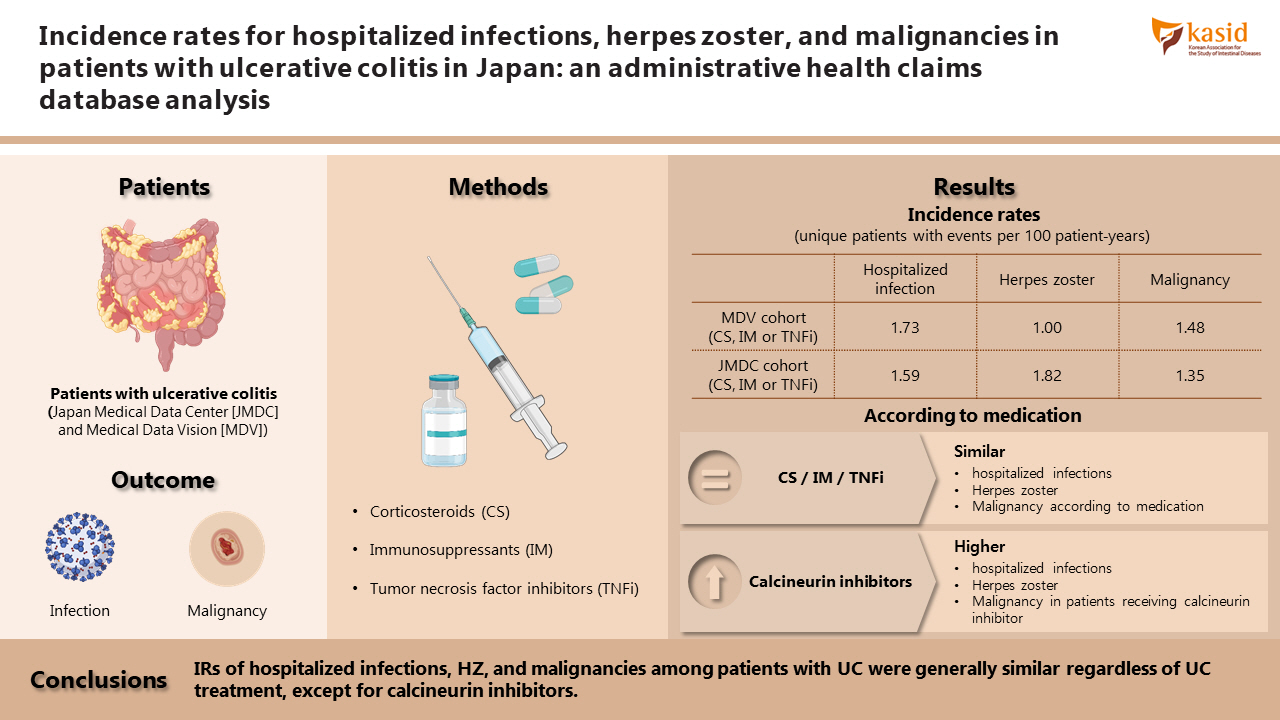 |
 |
- Search
| Intest Res > Volume 21(1); 2023 > Article |
|
Abstract
Background/Aims
Methods
Results
ADDITIONAL INFORMATION
Conflict of Interest
Matsuoka K has served as a scientific adviser for EA Pharma; has served on advisory boards for Boehringer Ingelheim, Bristol-Meyers Squibb, and Eli Lilly; has received personal fees from AbbVie, EA Pharma, Janssen, JIMRO, Kissei Pharmaceutical, Kyorin Pharmaceutical, Mitsubishi Tanabe Pharma, Mochida Pharmaceutical, Pfizer Inc, Takeda Pharmaceutical, and Zeria Pharmaceutical; and has received research grants from AbbVie, EA Pharma, JIMRO, Kissei Pharmaceutical, Kyorin Pharmaceutical, Mitsubishi Tanabe Pharma, Mochida Pharmaceutical, Nippon Kayaku, and Takeda Pharmaceutical. Togo K, Hoshi M, and Arai S are employees and stockholders of Pfizer Japan Inc. Yoshii N was a former employee of Pfizer Japan Inc.
Matsuoka K is an editorial board member of the journal but was not involved in the peer reviewer selection, evaluation, or decision process of this article. No other potential conflicts of interest relevant to this article were reported.
Data Sharing Statement
Upon request, and subject to review, Pfizer will provide the data that support the findings of this study. Subject to certain criteria, conditions and exceptions, Pfizer may also provide access to the related individual anonymized participant data. See https://www.pfizer.com/science/clinical-trials/trial-data-and-results for more information.
Author Contribution
Conceptualization: Matsuoka K, Togo K, Yoshii N, Arai S. Methodology: Togo K, Yoshii N, Arai S. Formal analysis: all authors. Funding acquisition: all authors. Project administration: Arai S. Visualization: all authors. Writing - original draft: all authors. Writing - review and editing: all authors. Approval of final manuscript: all authors.
Non-Author Contributions
Medical writing support, under the guidance of the authors, was provided by Helen Findlow, PhD, CMC Connect, McCann Health Medical Communications and was funded by Pfizer Japan Inc, Tokyo, Japan in accordance with Good Publication Practice (GPP3) guidelines (Ann Intern Med 2015;163: 461-464). Data analytics support was provided by the Institute of Japanese Union of Scientists & Engineers and funded by Pfizer Japan Inc.
Supplementary Material
Fig. 1.
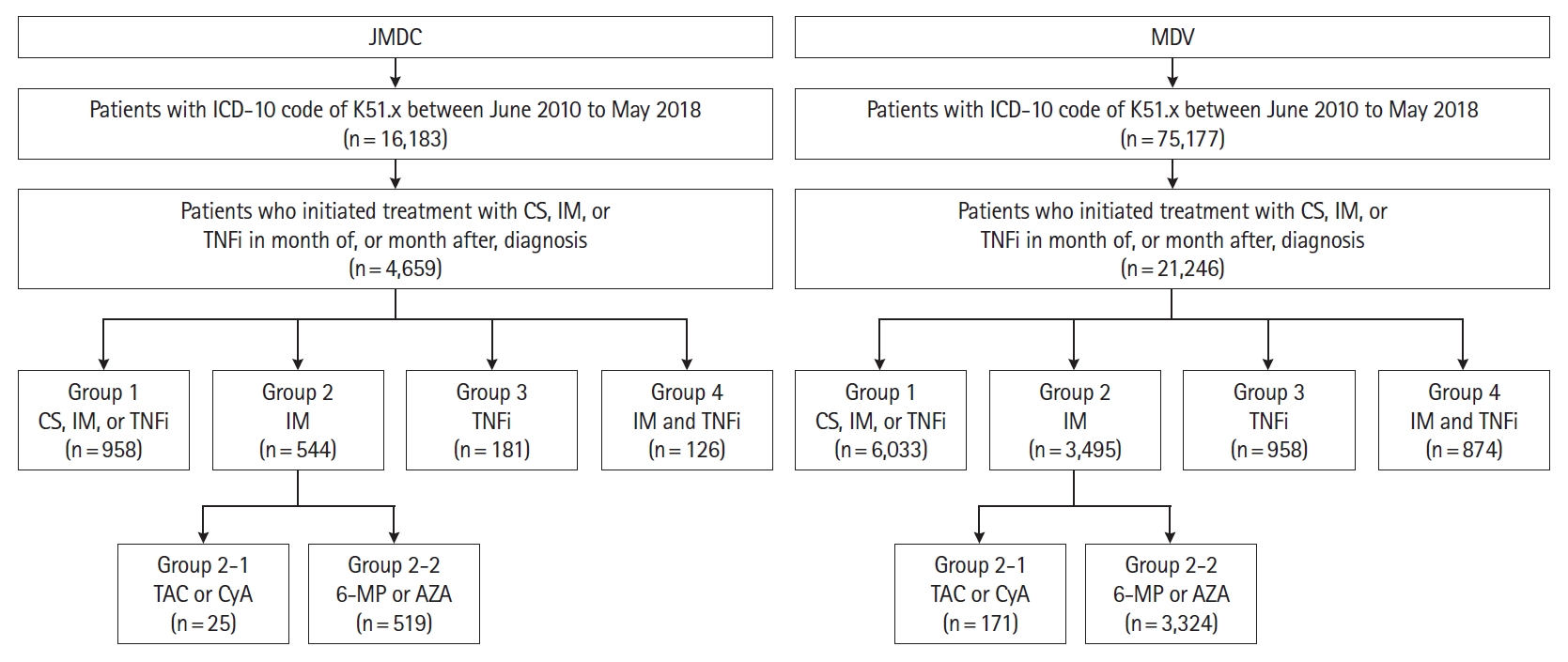
Fig. 2.
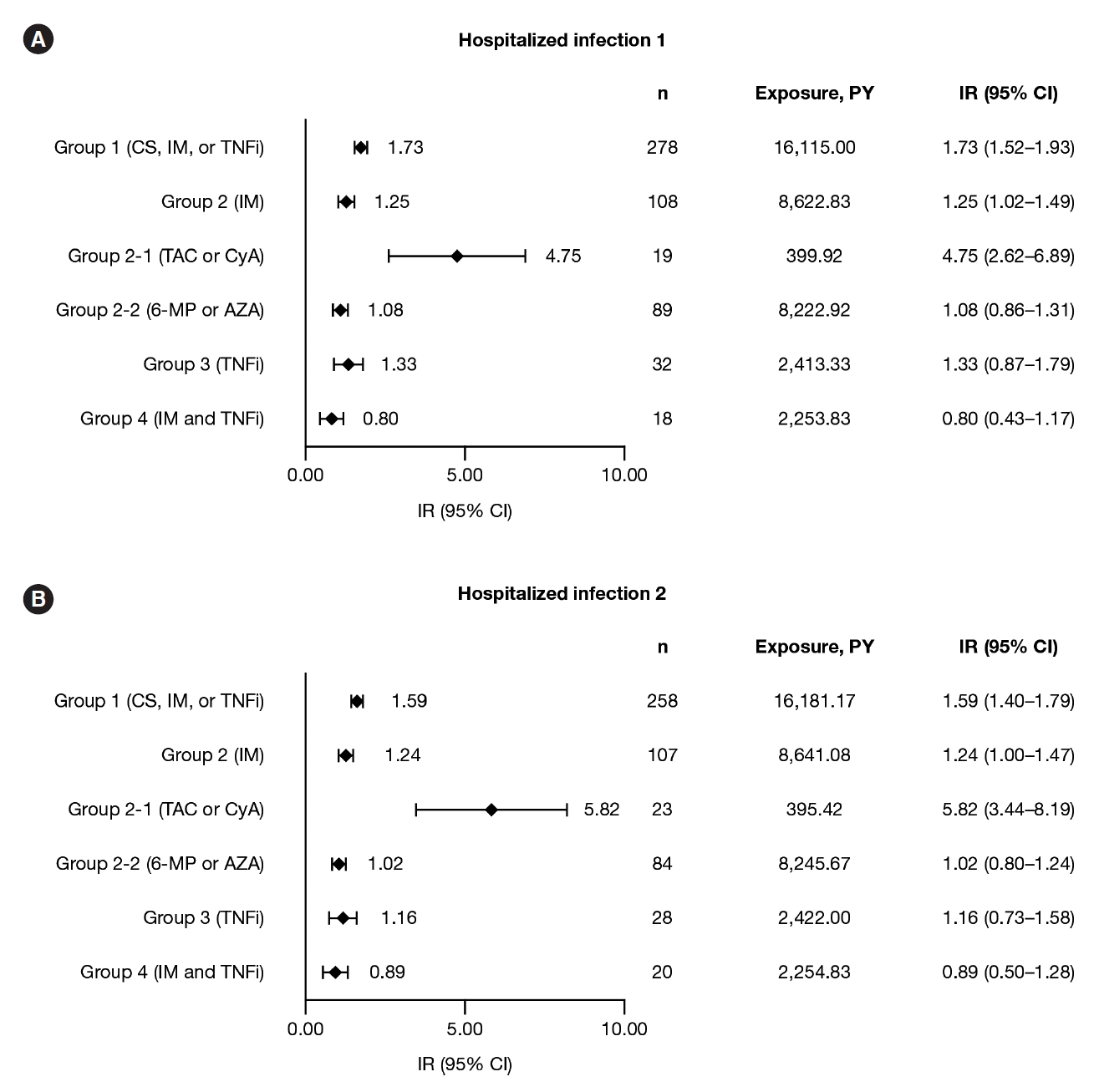
Fig. 3.
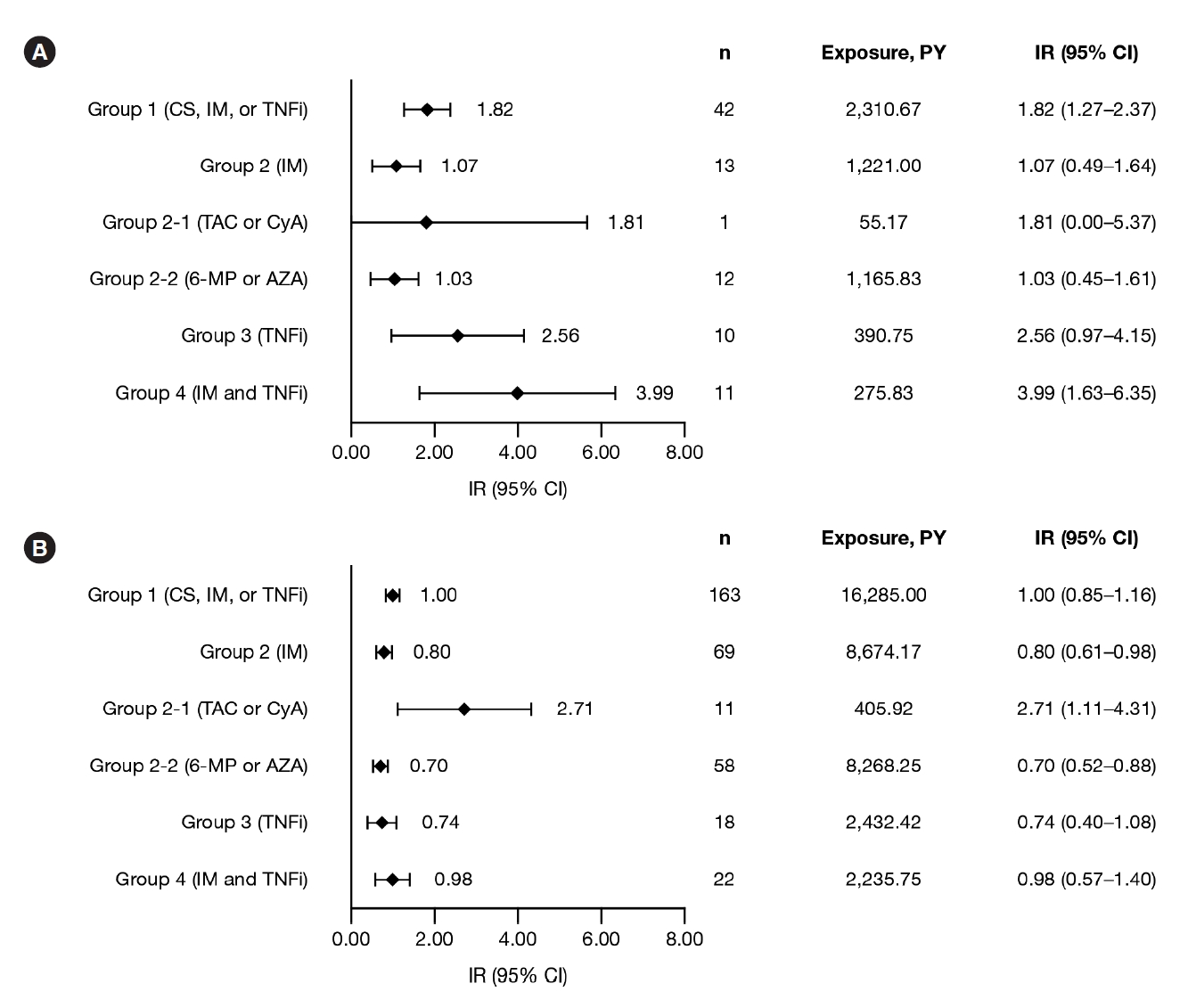
Fig. 4.
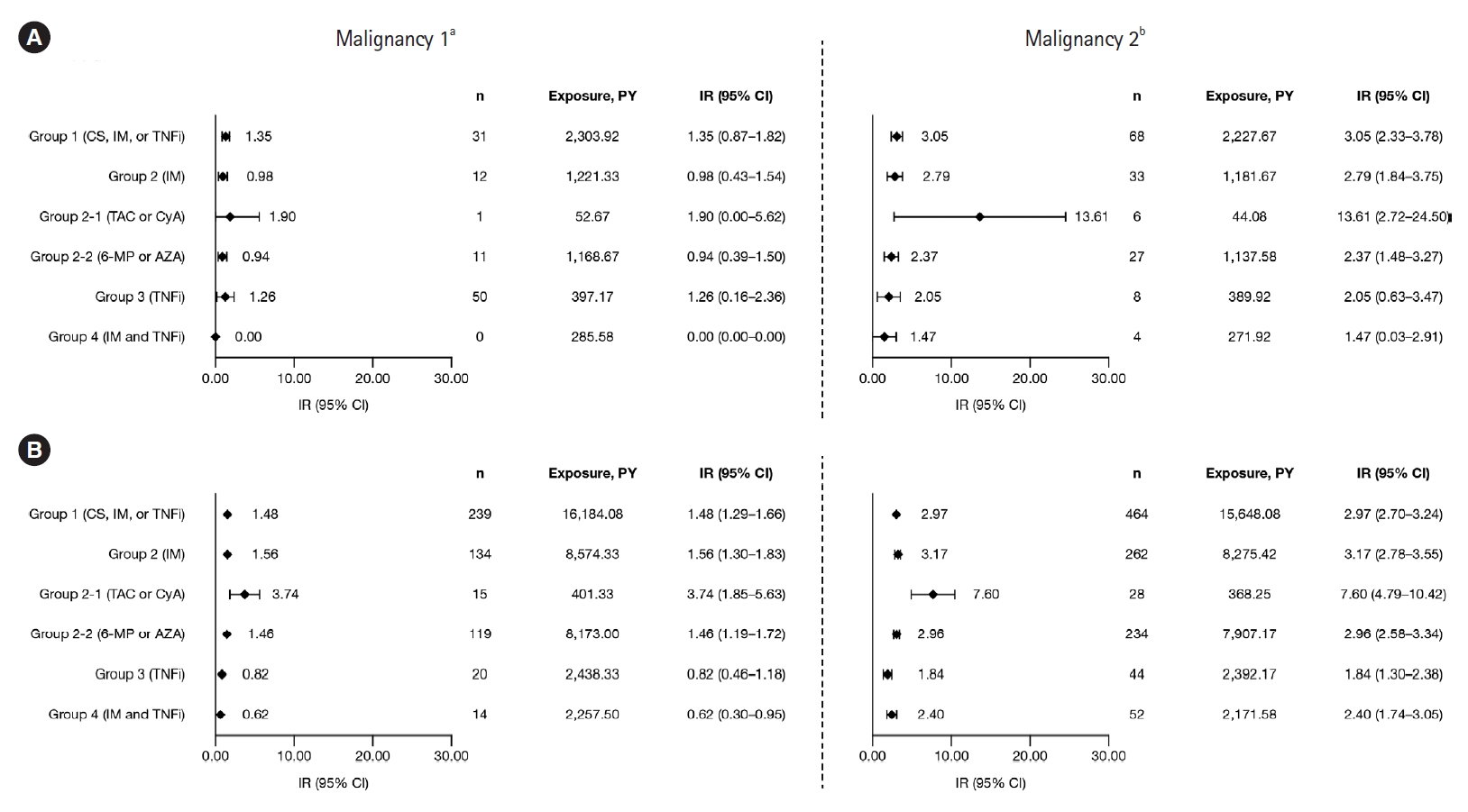
Table 1.
| Baseline characteristic | Group 1 (CS, IM, or TNFi) | Group 2 (IM) | Group 2-1 (TAC or CyA) | Group 2-2 (6-MP or AZA) | Group 3 (TNFi) | Group 4 (IM and TNFi) | |
|---|---|---|---|---|---|---|---|
| Total No. | 958 | 544 | 25 | 519 | 181 | 126 | |
| Female sex, No. (%) | 352 (36.7) | 201 (36.9) | 14 (56.0) | 187 (36.0) | 63 (34.8) | 37 (29.4) | |
| Age (yr) | |||||||
| Mean ± SD | 41.3 ± 12.8 | 42.3 ± 12.6 | 48.3 ± 12.3 | 42.0 ± 12.5 | 39.6 ± 12.3 | 40.9 ± 11.6 | |
| Median (range) | 41 (18-73) | 42 (18-73) | 49 (19-72) | 42 (18-73) | 39 (18-68) | 41 (18-66) | |
| Age category (yr), No (%) | |||||||
| < 35 | 306 (31.9) | 156 (28.7) | 3 (12.0) | 153 (29.5) | 67 (37.0) | 36 (28.6) | |
| ≥ 35 | 652 (68.1) | 388 (71.3) | 22 (88.0) | 366 (70.5) | 114 (63.0) | 90 (71.4) | |
| < 50 | 687 (71.7) | 372 (68.4) | 13 (52.0) | 359 (69.2) | 140 (77.3) | 95 (75.4) | |
| ≥ 50 | 271 (28.3) | 172 (31.6) | 12 (48.0) | 160 (30.8) | 41 (22.7) | 31 (24.6) | |
| < 65 | 931 (97.2) | 527 (96.9) | 23 (92.0) | 504 (97.1) | 177 (97.8) | 124 (98.4) | |
| ≥ 65 to < 75 | 27 (2.8) | 17 (3.1) | 2 (8.0) | 15 (2.9) | 4 (2.2) | 2 (1.6) | |
| Treatment at index date, No. (%) | |||||||
| IM | 562 (58.7) | 544 (100.0) | 25 (100.0) | 519 (100.0) | 0 | 126 (100.0) | |
| TNFi | 223 (23.3) | 0 | 0 | 0 | 181 (100.0) | 126 (100.0) | |
| Corticosteroid | 351 (36.6) | 119 (21.9) | 6 (24.0) | 113 (21.8) | 34 (18.8) | 28 (22.2) | |
| Corticosteroid dosagea | |||||||
| Mean ± SD | 19.6 ± 18.1 | 19.7 ± 17.5 | 13.7 ± 13.2 | 20.1 ± 17.7 | 18.6 ± 15.0 | 16.0 ± 10.9 | |
| Median (range) | 15.0 (0.5-80.0) | 16.3 (1.0-70.0) | 7.5 (2.0-30.7) | 16.3 (1.0-70.0) | 17.9 (1.0-72.5) | 15.3 (1.0-40.0) | |
| Follow-up duration (yr) | |||||||
| Mean ± SD | 2.5 ± 1.5 | 2.3 ± 1.3 | 2.3 ± 1.2 | 2.3 ± 1.3 | 2.3 ± 1.4 | 2.3 ± 1.2 | |
| Median (range) | 2.0 (1.0-8.0) | 1.9 (1.0-7.7) | 1.8 (1.0-5.1) | 1.9 (1.0-7.7) | 1.7 (1.0-7.8) | 2.0 (1.0-5.7) | |
Table 2.
| Baseline characteristic | Group 1 (CS, IM, or TNFi) | Group 2 (IM) | Group 2-1 (TAC or CyA) | Group 2-2 (6-MP or AZA) | Group 3 (TNFi) | Group 4 (IM and TNFi) | |
|---|---|---|---|---|---|---|---|
| Total No. | 6,033 | 3,495 | 171 | 3,324 | 958 | 874 | |
| Female sex, No. (%) | 2,594 (43.0) | 1,461 (41.8) | 107 (62.6) | 1,354 (40.7) | 470 (49.1) | 304 (34.8) | |
| Age (yr) | |||||||
| Mean ± SD | 47.5 ± 16.9 | 47.3 ± 16.4 | 54.4 ± 17.8 | 47.0 ± 16.2 | 46.2 ± 16.3 | 44.4 ± 15.6 | |
| Median (range) | 47 (18-97) | 47 (18-97) | 57 (18-93) | 47 (18-97) | 45 (18-90) | 44 (18-92) | |
| Age category (yr), No. (%) | |||||||
| < 35 | 1,562 (25.9) | 872 (24.9) | 26 (15.2) | 846 (25.5) | 271 (28.3) | 265 (30.3) | |
| ≥ 35 | 4,471 (74.1) | 2,623 (75.1) | 145 (84.8) | 2,478 (74.5) | 687 (71.7) | 609 (69.7) | |
| < 50 | 3,351 (55.5) | 1,937 (55.4) | 66 (38.6) | 1,871 (56.3) | 577 (60.2) | 553 (63.3) | |
| ≥ 50 | 2,682 (44.5) | 1,558 (44.6) | 105 (61.4) | 1,453 (43.7) | 381 (39.8) | 321 (36.7) | |
| < 65 | 4,884 (81.0) | 2,889 (82.7) | 108 (63.2) | 2,781 (83.7) | 786 (82.0) | 762 (87.2) | |
| ≥ 65 | 1,149 (19.0) | 606 (17.3) | 63 (36.8) | 543 (16.3) | 172 (18.0) | 112 (12.8) | |
| Treatment at index date, No. (%) | |||||||
| IM | 3,727 (61.8) | 3,494 (100.0) | 171 (100.0) | 3,324 (100.0) | 0 | 874 (100.0) | |
| TNFi | 1,308 (21.7) | 0 | 0 | 0 | 958 (100.0) | 874 (100.0) | |
| Corticosteroid | 2,137 (35.4) | 820 (23.5) | 46 (26.9) | 774 (23.3) | 187 (19.5) | 156 (17.8) | |
| Corticosteroid dosagea | |||||||
| Mean ± SD | 22.9 ± 19.4 | 21.5 ± 17.2 | 10.6 ± 11.7 | 22.1 ± 17.3 | 20.9 ± 17.5 | 19.2 ± 16.3 | |
| Median (range) | 20.0 (0.5-150.0) | 19.4 (0.5-133.3) | 4.5 (1.0-50.0) | 20.0 (0.5-133.3) | 20.0 (0.5-100.0) | 17.9 (0.5-86.7) | |
| Follow-up duration (yr) | |||||||
| Mean ± SD | 2.8 ± 1.7 | 2.5 ± 1.5 | 2.5 ± 1.5 | 2.5 ± 1.5 | 2.6 ± 1.5 | 2.6 ± 1.5 | |
| Median (range) | 2.2 (1.0-9.8) | 2.0 (1.0-9.7) | 1.9 (1.0-8.7) | 2.0 (1.0-9.7) | 2.1 (1.0-8.9) | 2.2 (1.0-9.4) | |






